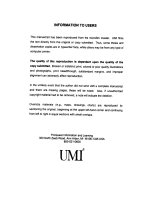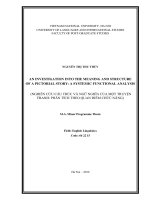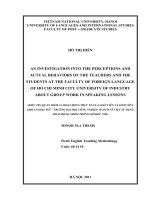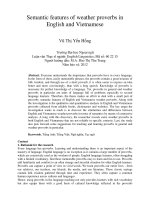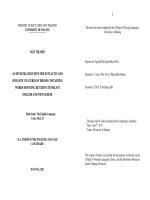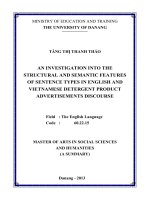An investigation into the structural and semantic features of sentence types in english and vietnamese detergent product advertisements discourse
Bạn đang xem bản rút gọn của tài liệu. Xem và tải ngay bản đầy đủ của tài liệu tại đây (248.52 KB, 26 trang )
MINISTRY OF EDUCATION AND TRAINING
THE UNIVERSITY OF DANANG
TĂNG THỊ THANH THẢO
AN INVESTIGATION INTO THE
STRUCTURAL AND SEMANTIC FEATURES
OF SENTENCE TYPES IN ENGLISH AND
VIETNAMESE DETERGENT PRODUCT
ADVERTISEMENTS DISCOURSE
Field : The English Language
Code :
60.22.15
MASTER OF ARTS IN SOCIAL SCIENCES
AND HUMANITIES
(A SUMMARY)
Danang - 2013
The study has been completed at
Danang University
Supervisor: Assoc. Prof. Dr. PHAN VĂN HÒA
Examiner 1: Assoc. Prof. Dr.Trần Văn Phước
Examiner 2: Dr.Trần Quang Hải
The thesis was defended at the Examining Committee
Time : 15/12/2013
Venue : The University of Danang
The origin of the thesis is accessible for the purpose of reference at:
- The College of Foreign Languages Library, The University of
Danang
- Information Resources Centre, The University of Danang
1
CHAPTER 1
INTRODUCTION
1.1 RATIONAL
Nowadays, together with the development of the society,
advertising plays an integral part in contributing to the success of
companies as well as other firms. Advertisement is called a form
of persuasive communication. We can see advertisement
everywhere, on Television, newspapers, magazines… and there
are various kinds of advertisement to attract the notice from
customers. As a result, many companies rely on advertising these
days to boost sales of their products or services as well as build a
connection with their audience and create competition with their
rival firms. Advertising is crucial to a company's success and it is
becoming more and more important to be backed by a creative and
unique campaign. Here are two examples of detergent product
advertisements:
At Omo, we say that dirt is good!
Also sold as Persil, Skip, Breeze, Ala, Wisk, Surf and Rinso in
some parts of the world, Omo’s unique technology gives your
family the freedom to get dirty, safe in the knowledge that Omo
will remove those awkward stains.
( />Sạch bóng, không còn vi khuẩn – là những điều bạn nghĩ tới khi
nói về bồn cầu. Nhưng để làm được điều này không đơn giản chút
nào. Hãy yên tâm, GIFT tẩy bồn cầu sẽ giúp bạn! Với kiểu dáng
2
chai có độ cong đặc biệt, Toilet Gift dễ dàng tẩy sạch mọi ngóc
ngách của bồn cầu đem lại cho bạn bồn cầu như ý mà vẫn tiết
kiệm được thời gian.
( />It is obvious that each language has its own structures and
semantics of sentence types. English and Vietnamese are not
exceptions. I realize that there are so many interesting things that
need to be studied in advertisement discourse in English and
Vietnamese. Therefore, advertisement is chosen as the subject area
of my thesis. The research is intended to cover sentence types in
English and Vietnamese Advertisement discourse as well as find
out the similarities and differences of the two languages in terms
of structures and semantics.
1.2. AIMS AND OBJECTIVES
1.2.1 Aims of the study
The study aims at analyzing the structures and semantics of
sentence types in detergent products advertisement discourse. It is
carried out to show the similarities and differences in English and
Vietnamese languages. The findings of the study will help users of
English achieve good writing of English advertisement.
1.2.2 Objectives of the study
The study is intended:
-
To find out the structures and semantics of sentence
types in English and Vietnamese Advertisement
discourse
3
-
To find out the similarities and differences between
English and Vietnamese in terms of these above
aspects.
-
To give some implications in teaching and learning
English, especially in writing skill.
1.3 RESEARCH QUESTIONS
The study is to answer the following questions:
1. What are structural features of sentence types in
detergent product advertisements?
2. What are semantic features of sentence types in
detergent product advertisements?
3. What are the similarities and differences of the two
languages in terms of the above aspects?
1.4 THE SIGNIFICANCE OF THE STUDY
When investigating this study, we are always aware that this
will be deep and extensive work. It is of great significance to
linguistic theory and practice. That is to say the study is intended to:
- help English learners as well as readers to know well
about sentence types in English and Vietnamese
advertisement discourse
- promote the effectiveness of advertising in English and
Vietnamese
1.5 SCOPE OF THE STUDY
This study aims to carry out an investigation of detergent
product advertisements discourse. Specifically, this study focuses
on describing, analyzing and contrasting structures and semantics
4
of sentences types in English and Vietnamese advertisement
discourse.
1.6 ORGANIZATION OF THE STUDY
The study is organized into five chapters as follows:
Chapter 1: Introduction
Chapter 2: Literature Review and Theoretical Background
Chapter 3: Research Methods and Procedures
Chapter 4: Findings and Discussion
Chapter 5: Conclusion
CHAPTER 2
LITERATURE REVIEW
AND THEORETICAL BACKGROUND
2.1. PREVIOUS STUDIES RELATED TO THE RESEARCH
Structures and Semantics of sentence types is a familiar
topic that attracts a lot of attention from researchers all over the
world. In 1985, in A comprehensive grammar of the English
language, Quirk R., Greenbaum S., Leech G., Svartvik J.
examined types of sentences in strutures and semantics.
In
Structures for Semantics (1991), Fred Landman gave a
background in semantics to develop skills of formalization and it
made research in semantics accessible. Marjolyn Verspoor has an
English analysis at sentence, clause and phrase level. He also
gives traditional terms and concepts of English syntax in English
Sentence Analysis (2000). The next researcher followed this trend
is Nigel Fabb. In Sentences structure (2005), he introduced the
5
evidence for sentence structure and revealed its purpose as well as
gives a problem-solving approach to language. Meeds R., Bradley
S. D. (2007) stated in The Role of the Sentence and Its Importance
in Marketing Communications that in communication, especially
in advertising, sentence plays a vital role in making the brand
become successful in the market.
In Vietnam, a lot of researchers follow this trend.
Typically, Hoang Trong Phien with “Ngữ pháp tiếng Việt: câu”
(1980) or Le Xuan Thai with Hệ thống câu trong tiếng Việt
(1995). In the following years, Nguyễn Minh Thuyết and Nguyễn
Văn Hiệp gives some similar matter in “Thành phần câu tiếng
Việt” (1998) or Diệp Quang Ban in Ngữ pháp tiếng Việt (2005).
There are also some master theses such as Nguyen Thi Phuong
Hong (2003): A discourse analysis on job advertisements in
English and Vietnamese or Nguyen Thi Thuy Duong (2005):
Information focus in English and Vietnamese sentences
Although there have been many studies on advertisements,
there is no any research on the structural and memantic features ò
sentence types in English and Vietnamese detergent product
advertisement that has been conducted up to now. Therefore, I
choose to do the research entitled “An investigation into the
Structural and Semantic features of sentence types in English
and Vietnamese detergent advertisements discourse”” with the
hope to make a small contribution to the discourse analysis of
advertisements as well as language teaching.
6
2.2. TREORETICAL BACKGROUND
2.2.1. Sentence definitions
According to Throne (1997), “a sentence is a grammatical
construction that makes sense on its own. In writing, it begins with
a capital letter and ends with a full stop or an exclamation or
question mark.”. Ray Jackendoff states that sentence that is a
complete unit of speech formed grammatically according to the
rule of a certain language is the most important tool to form,
demonstrate and transfer the belief (1994).
The subject is the principal part of the sentence, expressed
by a word or a group of words, which is grammatically
independent of the other parts of the sentence and with which the
second principle part, the predicate, agrees in number and person.
The subject denotes a person, a thing or a phenomenon. The
subject of a sentence can be expressed by a noun, pronoun,
numeral… The predicate is the second part of the sentence which
expresses an action, a state, or quality of the person, thing or
phenomenon denoted by the subject. It agrees with the subject in
number and person.
In Vietnamese, Diệp Quang Ban (1972) defined sentence
as a unit of language research which has independently
grammatical structure and
intonation end, and comparatively
complete meaning, attitude or estimation of speaker in order for
his or her thoughts or feelings to be formed, expressed or
communicated. According to Mai Ngọc Chừ, Vũ Đức Nghiệu,
Hoàng Trọng Phiến (2003), sentences are languge units that have
7
independent grammatical components with intonation to transfer
belief and love.
*) Sentence used in advertisement
Producers have been taking advantage of sentences in
advertising in order to inform customers about details of the
products. In terms of advertisement, besides the function of
informing, sentence is an element which has a strong
persuasion, which is also a second aim of advertisement. As we
can see, due to the fact that most of the ideas on advertisements
are transferred through sentences, whether ideas of producers
are imparted successfully or not depends on sentences. As a
result, sentence is a sharp tool for advertisers to show their
ultimate ideas.
2.2.2 Structural and semantic features of sentence types
a. Structural features of sentence types
a1. Simple sentence: Simple sentences contain one
independent clause, that is a group of words with one subject and
predicate combination that can stand alone.
- Simple sentences with Direct object and Indirect object
In a sentence, the subject and verb may be followed by an
object. An object is a noun or pronoun that gives meaning to the
subject and verb of the sentence. Not all sentences contain objects,
but some may contain one or more. There are two kinds of objects
within a sentence: direct and indirect objects.
- Simple sentences with adverbials
Adverbials indicate when or how or why or more generally
8
in what circumstances the action took place. Indeed, adverbials
can go anywhere in the sentence.
a2. Compound sentence
When two or more independent clauses are joined by a
coordinate conjunction, they remain independent clauses, but
become one compound sentence
a3. Complex sentence: A complex sentence is made from
an independent clause and a dependent clause joined together.
a4. Compound – Complex sentence
Compound – Complex sentence is a combination of a compound
sentence and a complex sentence. They require a minimum of
three clauses; two independent and one dependent.
a5. Inverted sentence
Some linguistics stated that inversion is a syntax process
introducing entities into discourse. In linguist, inversion is any of
several grammatical constructions where two expressions switch
their canonical order of appearance, that is, they invert. For
example:
(2.1)
So angry was the doctor that he shouted.
(2.2)
Vị bác sĩ quá tức giận đến nỗi ông ấy đã hét lên.
b. Semantic features of sentence types in detergent
product advertisements
b1. Declarative sentence
The content of information is one of the compulsory
things and it also has a leading role in advertisement. Language
has a powerful influence over people and their behavior. This is
9
especially true in the fields of marketing and advertising. The
choice of language to convey specific messages with the intention
of influencing people is vitally important.
b2. Imperative sentences (Commands)
* Commands without a subject: This is the most common
category of command that differs from a statement
(2.3)
Go to bed early!
Sometimes there are some markers of politeness, which is
placed at the beginning or end of the imperative sentences (1) or if
one changes the command into a question or a statement (2)
(2.4)
Shut the door, please! (1)
Will you shut the door? (2)
b3. Interrogative sentence
b4. Exclamatory sentence
2.2.3. Overview of advertising
a. Definitions of Advertising
According to Arens (1982) “Advertising is the structured
and composed nonpersonal communication of information, usually
paid for and usually persuasive in nature, about products (goods,
services, and ideas) by identified sponsors through various media”
According to Cook (1992) “Advertising means clearly
identifiable, paid for communication in the media, which aims to
persuade, inform and sell. But the world is also used to cover a
much broader range of activities-from design to public relations- by
what are often the same organizations, using similar sills”.
Therefore, advertising is one of the main elements of the marketing
10
mix
(A
planned
mix
of
the
controllable elements of
a product's marketing plan). It involves using paid media to
communicate persuasive information about a destination, product
or service. Advertising is used to provide information and
influence customers’ attention attitudes and it can be directed at
customers either in a targeted narrow way or in broad geographic
applications.
Goddard (1998) argued advertising is not just about the
commercial promotion of branded product, but can also the idea of
texts whose intention is “to enhance the image of an individual,
group or organization”.
In Harris and Sheldon’s book entitled “Advertising and
The public”
(1962) defined that “Advertising designed to spread information with a
view to promoting the sales of marketable goods and services”.
b. Classification of Advertising
Print Advertising
Broadcast Advertising
Outdoor Advertising
Covert Advertising
Public Service Advertising
c. Language of Advertising
Goddard (1998) stated that “Vocabulary is chosen to
promote positive associations in the minds of the target
audiences”. In addition, Delin (2000) claimed that “Vocabulary is
clearly a central element in building the image of a product”.
11
d. Objectives of advertisements
The study is intended:
-
To find out the structures and semantics of sentence
types in English and Vietnamese Advertisement
discourse
-
To find out the similarities and differences between
English and Vietnamese in terms of these above
aspects.
-
To give some implications in teaching and learning
English, especially in writing skill.
e. Functions of Advertising
No one can deny that advertising is very crucial not only
to consumers, but also to social development. In fact, it performs
three main roles in society.
Marketing role- helping companies sell their products or
services.
To the producers, advertising provides the chances of
promoting the products or services, communicating with the
consumers and developing the business, which does much good to
economic development.
Educational role- helping people learn about new
products and services
As consumers, we can get information of the world from
advertisement. Then it performs the educational role. We can
compare the products or services of one brand with another from
which we can make our choices.
12
Social role- helping increase productivity and raise the
standard of living
To the society, advertising can accelerate the growth of
economy, and thus improve the standard of living. It also promotes
the mass-media and gives the society very rich cultural meaning.
Advertising has evolved into a vastly complex form of
communication, with literally thousands of different ways for a
business to get a message to the consumer. It could be said that
cave paintings in some way represented the first forms of
advertising, although the earliest recognized version of what we
know as advertising was done on papyrus by the Egyptians. And in
Pompeii, the ruins suggest that advertising was commonplace.
However, today the advertiser has a vast array of choices. Over the
time, the main media of advertising include magazines,
newspapers, radio and television. Besides, there are some other
means of advertising such as billboards, posters, outdoor signs,
banners at sporting events, logos on clothing and so on. In
addition, the internet alone provides many of these, with the
advent of branded viral videos, banners, advertorials, sponsored
websites, branded chat rooms and so much more.
Detergent
advertisements
often
take
magazines,
newspapers, television and the internet as their principal
advertising media. In this thesis, we only use detergent
advertisements collected from websites and newspapers in English
and Vietnamese for analysis.
13
2.2.4. Overview of Detergent product advertisements
a. Definitions of Detergent
According to the online dictionary Wikipedia, detergent is
a cleansing agent, especially a surface-active chemical such as an
alkyl sulphonate, widely used in industry, laundering, etc. In other
words, detergent is called a cleaning agent that helps to remove
dirt and grease from porous surfaces (such as fabrics, clothes, nontreated wood) and/or non-porous surfaces (such as metals, plastics,
treated wood). All detergents are made principally of soaps or
surfactants. Detergent is any of a group of synthetic, organic,
liquid or water-soluble cleaning agents that, unlike soap, are not
prepared from fats and oils, are not inactivated by hard water, and
have wetting-agent and emulsifying-agent properties. Besides, it is
a similar substance that is oil-soluble and capable of holding
insoluble foreign matter in suspension, used in lubricating oils,
dry-cleaning preparations, etc.
b. Definition of Detergent Advertising
Detergent advertising is the activity of introducing
detergent products or services through advertisements on
television,
newspaper,
magazines
or
other
means
of
communication. It has the ability to reach a mass audience at a
national level.
14
CHAPTER 3
METHOD AND PROCEDURES
3.1. RESEARCH METHODS
The study was designed in the qualitative and quantitative
approaches. Qualitative method was used to describe and analyze
the data to find out the structures, semantics of sentence types in
English detergent products advertisement discourse and give some
similarities as well as differences between English and
Vietnamese detergent products advertisement discourse.
With the aim of achieving the goal put at the beginning, it
is impossible to use a single method, several methods were
employed.
3.2. RESEARCH PROCEDURES
The steps will be involved:
-
Collecting data: detergent product advertisements in
English and Vietnamese were read.
-
Making a comparison to find out the similarities and
differences between sentence types in advertisement
discourse in the two languages in terms of structures
and semantics.
-
Synthesizing and draw conclusion.
-
Giving some implications in teaching and learning
English and some suggestions for further research.
15
3.3. DATA COLLECTION AND DATA ANALYSIS
3.3.1. Data collection
- In this study, the samples for the investigation were
mainly taken from websites. Samples of English detergent
products were taken from some newapapers or magazines.
Especially, most samples were taken from popuplar websites for
example www.tuicare.com or www.dreft.com.
Samples of
Vietnamese detergent products were from Thanh Nien, Tien
Phong, Tạp chí Gia Đình, Báo Phụ nữ newspaper or websites such
as vnclean.net or www.hungphatpro.com
- 100 samples in English and 100 samples in VDPAs from
2010 and 2013 were used for this thesis.
3.3.2. Description of Samples
Detergent product advertisements used for analysis in this
thesis were taken from websites or newspapers. Thus, at first,
more than 100 pieces of detergent product advertisements of
various lengths and forms are collected. These models were
classified into laundry detergent, dishes detergent, glass
detergent,…
3.3.3. Data Analysis
3.4. RELIABILITY AND VALIDITY
Since the speeches collected from online newspapers for this study
are a totally authentic source of data, not invented examples, the
quality of the data is quite reliable. These data are not out of date
(from the year 2010 to 2013).
16
CHAPTER 4
FINDINGS AND DISCUSSION
4.1. STRUCTURES OF SENTENCE TYPES IN EDPAS AND
VDPAS
4.1.1. Simple sentences in EDPAs and VDPAs
a. Simple sentences with Direct object and Indirect
object
(4.1) Palmolive gel dishwasher detergent provides powerful
cleaning action.
[A-12]
(4.7) LIX hương hoa xuân giúp quần áo sáng sạch hơn, lưu giữ
thật lâu hương hoa thơm mát.
[B-88]
b. Simple sentences with adverbials
(4.14) For almost four decades the Vernel brand has stood for
dreamily soft laundry and fascinating fragrance experiences.
[A-84]
(4.18) Qua hơn 30 năm xây dựng và phát triển thương hiệu, Mỹ
Hảo đã có một vị trí xứng đáng và đứng vững trên thị trường nói
chung hay những sản phẩm đáng tin cậy nói riêng.
[B-99]
c. Simple sentence with abstraction
(4.19) Clean - Polish - Protect – Preserve
[A-81]
17
4.1.2. Comparison of simple sentences in English and
VDPAs
Table 4.3: Frequency of simple sentences in English and VDPAs
English
Vietnamese
with Direct object
41,8%
43,3%
with Indirect object
24,2%
24,2%
With adverbials
6,5%
8,1%
with abstraction
9%
7,9%
81,5%
83,5%
Languages
Simple sentences
Total
4.1.3. Complex sentences in EDPAs
a. Complex sentence with Subject as a Clause
(4.26) A powerful clean that is gentle on skin ‘all® free clear OXI
helps get out your whole family’s toughest dirt & stains with no
dyes or perfumes.
[A-50]
b. Complex sentences with Predicate as a Clause
(4.1)
Ecosential by smart choice™ is an innovative line of
products uniquely designed for your home by appliance experts
[A-26]
(4.34) Vim là sản phẩm tẩy rửa hai trong một được khuyên dùng
cho bồn cầu và nhà tắm.
[B-07]
c. Complex sentences with Adverbial as a Clause
d. Complex sentences with Object as a Clause
18
(4.40) Our formulas use plant-based technology and essential oils
for a soft that lasts and lasts.
4.1.4. Comparison of complex sentences in detergent
advertisements
Table 4.6: Summary of complex sentences in detergent product
advertisements
English
Vietnamese
with Subject as a Clause
2,3%
1,2%
with Predicate as a Clause
0,7%
0,6%
with Adverb as a Clause
0,4%
0,2%
with Object as a Clause
3,6%
0,7%
Total
7,1%
2,7%
Languages
Complex sentences
4.1.5. Compound sentences in EDPAs and VDPAs
a. Compound sentences with Coordinating Conjunctions
*) Compound sentences with “and”
*) Compound sentences with “but”
*) Compound sentences with “so”
*) Compound sentences with “yet”
*) Compound sentences with “or”
b. Compound sentence with conjunctive adverbs
4.1.6. Comparison of compound sentences in detergent
advertisemnts
19
Table 4.9: Summary of compound sentences in detergent
advertisements
Languages
English
Vietnamese
with
5,6%
7,8%
with
3,2%
1,8%
1,1%
3,7%
9,2%
13,3%
Compound sentences
Compound
sentences
Coordinating Conjunctions
Compound
sentences
Conjunctive adverbs
Alternative compound sentence
Total
4.1.7. Compound – complex sentences in EDPAs
4.1.8. Comparison of Compound – complex sentence in
detergent product advertisements
4.1.9. Inverted sentences in EDPAs and VDPAs
4.1.10. Comparison of Inverted sentences in EDPAs
and VDPAs
4.2. SEMANTICS OF SENTENCE TYPES IN EDPAs AND
VDPAS
4.2.1. Declarative sentences in EDPAs and VDPAs
a. Declarative sentences with affirmative meaning
(4.83) With the use of these washing powders in small amount, we
believe that VIZZ can remove the dirt very easily.
20
(4.84) We offer a superior quality Washing Powder for our
clients, which is known for low leather formulation that works
well in top and front of loading machines. [A-02]
b. Declarative sentences with negative meaning
(4.99) Ecos Laundry Detergent Pods are all-in-one pouches with
just the right amount of detergent measured out for you. No
spills, no pouring, no waste! (Ecos)
(4.100) Just add with detergent. No measuring, and no mess!
4.2.3. Imperative sentences in English and VDPAs
Table 4.14: Frequency of imperative sentences in EDPAs
Imperative sentences
Occurance
Percentage
Imperative sentences with “Buy”
13
1,9%
Imperative sentences with “Use”
7
1,1%
Imperative sentences with “Try”
8
1,2%
Imperative
sentences
with
6
0,9%
sentences
with
7
1.1%
sentences
with
8
1,2%
Imperative sentences with “Let”
5
0,8%
Imperative
10
1,5%
Another imperative sentences
4
0,5%
Total
68
10,2%
“Forget”
Imperative
“Enjoy”
Imperative
“Choose”
sentences
with
“Don’t”
21
4.2.5. Interrogative sentences in EDPAs and VDPAs
Table 4.17: Frequency of interrogative sentences in EDPAs
Occurance Percentage
Interrogative sentences
Interrogative sentences with Yes-No 23
3,5%
questions
Interrogative
sentences
with
Wh- 19
2,9%
questions
Alternative Interrogative sentences
6
0,8%
Total
48
7,2%
CHAPTER 5
CONCLUSION AND IMPLICATIONS
5.1. CONCLUSION
In terms of structures of sentence types in EDPAs and
VDPAs, there are five types: simple, complex, compound,
compound-complex and inverted sentences. Simple sentence is
widely used in almost all detergent product advertisements
because of the fact that simple sentence enables customers to
get access to the products easily. Simple sentence takes up the
highest proportion of all kinds of sentence types in terms of
structural feature with 81,5% in English and 83,5% in
Vietnamese. Simple sentences with direct object account for
41,8% and 43,3% in English and Vietnamese respectively.
22
Sentences with Indirect object shares the same level in both
languages (24,2%). With 9% and only 7,9%. Simple sentences
with abstraction are considered to be the types that account for
the lowest proportion. Complex sentence includes four types:
with Subject as a Clause, with Predicate as a Clause, with
Adverbial as a Clause and with Object as a Clause. A
distinctive feature is that complex sentence in English
outnumber that of Vietnamese. In the four types, English
complex sentence with Object as a Clause has the highest rate
(3,6%) while complex sentence with Subject as a Clause is the
kind which ranks first in Vietnamese (1,2%). Compound
sentence ranks second after simple sentence. The proportion of
Vietnamese compound sentence is 13,3%, which is 5,1% more
than that in English. In both languages, compound sentence
with Coordinating Conjunctions shares the high level (5,6% in
English and 7,8% in Vietnamese). No compound – complex
sentence is found in 100 Vietnamese samples while there is
0,8% compound-complex sentence in English. In both
languages, inverted sentence with past participle is the most
common type in inverted sentence.
With regard to the semantics of sentence types in
English and VDPAs, the study examined the four types. The
first one is declarative sentence which is very common in
detergent advertisements. There is no difference of this type in
both languages with 78,1% in English and 19,1% in
Vietnamese. Although declarative sentence with affirmative
23
meaning in English is 54,5%, this type seems to be less than
declarative sentence with negative meaning in Vietnamese.
The second is imperative sentence with “Buy”, “Use”, “Try”,
“Forget”, “Enjoy”, “Choose”, “Let” and “Don’t”. In English,
imperative sentence account for 10,2%, higher than that in
Vietnamese (9,3%). In the above types, the proportion of
imperative sentence with “Buy” takes up the highest rate
(1,9% in both languages). The third is interrogative sentence
which is 8,8% in Vietnamese and 7,2% in English. The level
of interrogative sentence with Yes-No questions in English is
3,5%, which is 1,2% less than that in Vietnamese. The last
item examined here is exclamatory sentence. The proportion
of this type is quite low in Vietnamese (2,8%), lower than that
in English (4,5%).
5.2. IMPLICATIONS
On carrying out the study, I do hope that it will be a useful
material for anyone who is interested in advertising field including
copy-writers and advertising agencies
A copywriter can work for an advertising agency, a
corporate marketing department. While advertising, copywriters
use their skills to persuade people to buy a wide range of goods
and services; there are copywriters who specialize in specific areas
or niches.
5.3. LIMITATIONS OF THE STUDY
First of all, the corpus for this thesis is extremely
large, since detergent products advertisements cover every

